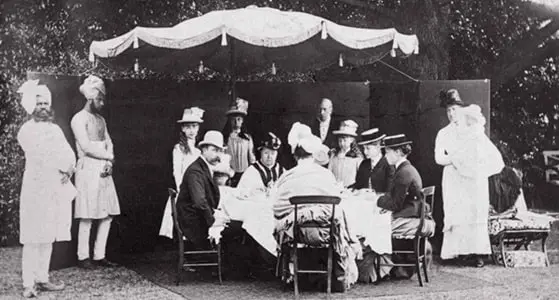Did you know that British rule in India started way back in 1757 with the Battle of Plassey? From then on, the British Raj kept on growing, and after so many rebellions, and the efforts of the Indian political leaders, the Britishers finally left India in 1947, handing the rule to the people of India. During this entire British Raj time, there were a lot of things that Britishers did, mostly exploiting the people, land, and the country as a whole. But still, there were some good aspects of British Rule in India too. Let’s find out.

Advantages of British Rule in India
1. Infrastructure Development
When the British ruled India, one of the biggest perks was the massive development of infrastructure they did over here. See, when India won independence in 1947, the subcontinent possessed the world’s fourth-largest railway network, with an expanding set of modern ports and roads linking its vast interior. And yes, this very infrastructure created profound new capacities for trade and mobility within and between India’s provinces.
2. Educational Reforms
The very shape of education in India was transformed by the establishment of the English system of education by the British, who set up large numbers of universities and colleges, including those of Calcutta, Bombay, and Madras in 1857. Of course, from the very beginning, English was made the language of teaching and learning. It was from there that a new class of literate and educated Indians emerged, who could communicate with the rest of the world and engage with the emerging global knowledge.
3. Modernization of Indian Society
The British took steps to reform various social practices in India. Which one though? Well, they banned practices like Sati (the burning of widows) and infanticide and encouraged widow remarriage. Often those pushing for reforms in India had a paternalistic view of Indian society and believed that it was their task to introduce or modernize India by introducing these so-called ‘humane’ codes.
4. Economic Changes
On top of all the benefits, there was one that helped the Indian economy. Yes, under British rule, a modern banking structure was established, trading ports were set up, and a common-market system was developed. These reforms connected the Indian economy to the global market. For the British, the purpose of the change was to benefit their economic interests, but it also led to a more formalized structure for the Indian economy down the line.
5. Political Unity
See, before British rule in India, there was a jumble of princely states and other territories with diverse rules. The British welded these territories and polities into one administrative system, which is where the idea of political unity and national India even originated. The British were very systematic in codifying the law and creating a centralized system of administration.
6. Introduction of Western Medical Practices
And we can’t deny the fact that the British brought Western medical practices to India, opening hospitals and administering vaccines that contributed to improvements in public hygiene and reduced outbreaks of disease. It also established medical institutions that trained Indian doctors in modern medical practices, a format that has continuously existed in India to this day.
Disadvantages of British Rule in India
1. Drained India’s Wealth
See, the British really knew how to squeeze India dry. The ‘drain of wealth’ theory, originally a catchphrase of Indian nationalists, demonstrates quite how much money was stolen from India to Britain during this period of time. High taxes were imposed on peasants, many industries such as textiles were wiped out, and the entire economy was restructured to remove profits and resources for British enrichment, leaving Indians in poor financial circumstances.
2. Famine and Poverty
British policies and poor management of agriculture caused repeated famines and widespread poverty. The Bengal Famine of 1943 is perhaps the most tragic example, with millions of people dying of starvation and other indirect effects as a result of British neglect. During that time, prioritizing the production of cash crops for export over the provision of satisfying basic needs for those who worked the land triggered food shortages that vastly exceeded the needs of urban consumers, not to mention military occupation to maintain the Raj.
3. Cultural and Social Disruption
The British imposed their so-called Western values, leading to a serious disruption of traditional Indian society. Their educational systems and policies impacted local customs, deprived people of cultural heritage, and promoted Western racial superiority, all of which divided social groups right here in the country, and seriously slowed down the growth of Indian society.
4. Political Crackdown
British brutality in relation to political dissent became apparent early on: laws such as the Rowlatt Act (1919) abolished the right to trial for political prisoners, the Jallianwala Bagh massacre in 1919 saw British troops fire on hundreds of unarmed Indian civilians, and bomb-resistant benches continued to be built around the Governor’s palace in Lahore into the later years of British rule.
5. Resource Exploitation
The British exploited India’s natural resources extensively to fuel their own industrial growth. This meant that there was heavy deforestation, mining, and extraction of raw materials such as cotton and jute, which was very toxic for the environment of India, and often the local people were not given due compensation for these natural resources.
6. Divide and Rule Tactics
The British rule in India was based on the policy of ‘divide and rule’. They were the ones to stir up rivalry among different religious and ethnic groups, and this ultimately resulted in the partition of India in 1947. They had this divide-and-rule tactic in multiple parts of the world, so that in the future if there is some conflict in any of their previously colonized countries, they can somehow make more profit out of it.
Quick Comparison Between Advantages and Disadvantages of British Rule In India
|
Advantages |
Disadvantages |
| Significant infrastructure development | Massive wealth extraction by the British |
| Establishment of English educational institutions | Repeated famines and widespread poverty |
| Social reforms, including the banning of harmful practices | Cultural disruption and imposition of Western values |
| Economic modernization, including banking and trade | Severe political repression and crackdowns |
| Political unification and administrative reforms | Extensive exploitation of natural resources |
| Introduction of Western medical practices | Divide and rule tactics leading to partition |

